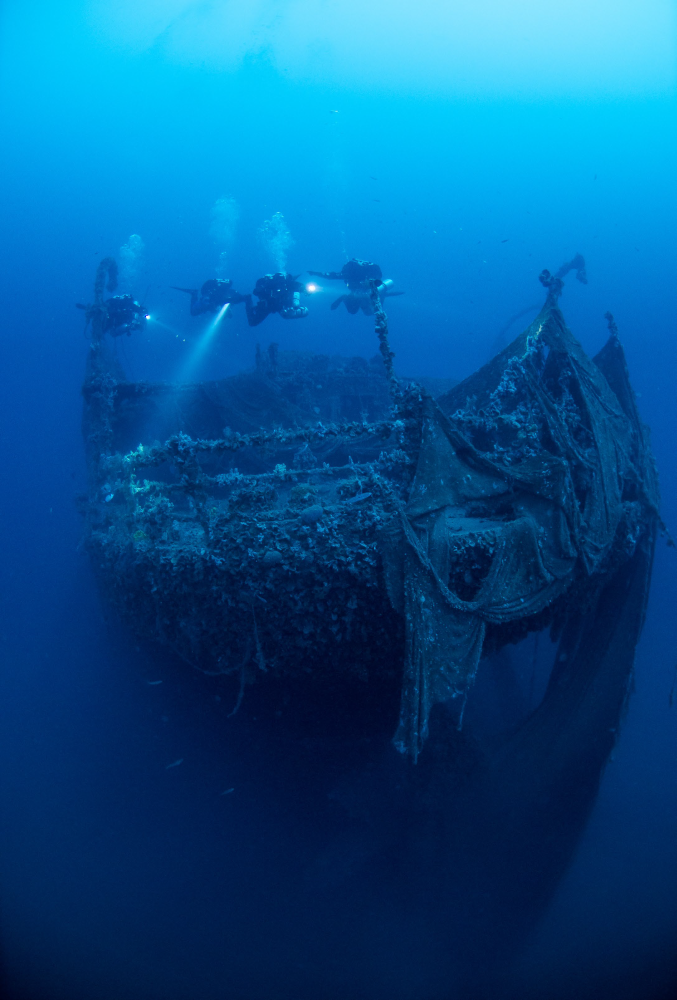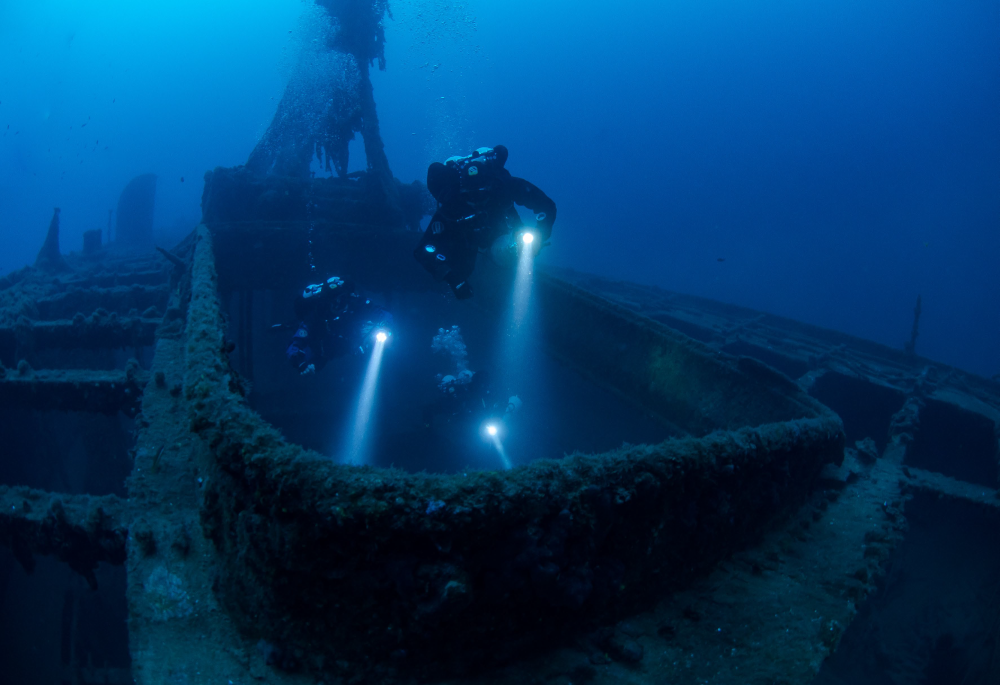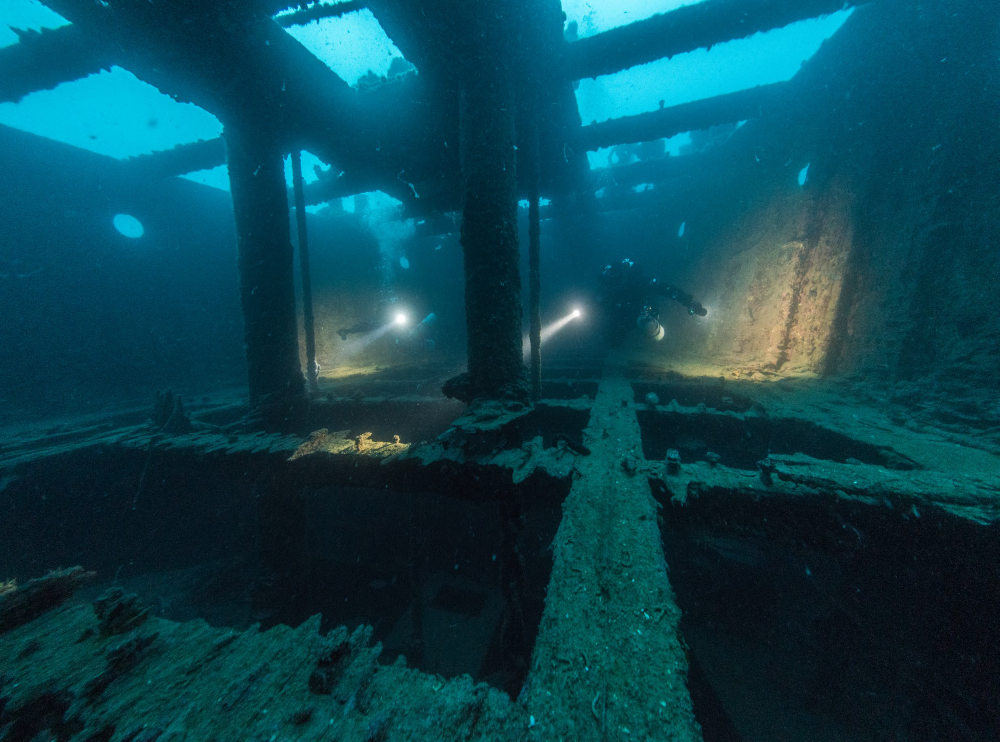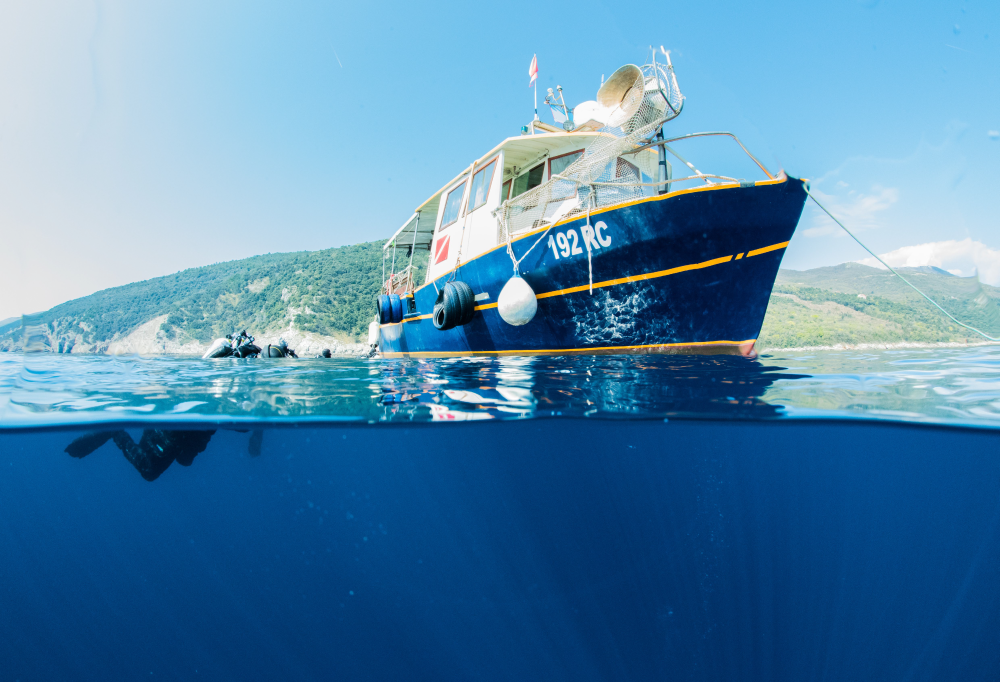This is another part of our special articles about Technical Diving.
Read also [Part 1] [Part 2][Part 3][Part 4.1]

After successfully finishing the first part of the T1 course in Croatia, of which you have been able to read all the ups and downs in the last post, we could start the second phase whereby we actually had to plan and dive our planned T1 dives. I hope you have had time to view the link, which I posted in the previous piece (part 4.1) on our Facebook page, which shows all the nice wrecks we have seen during our course. Images speak far louder than words!
It was a huge relief that we had been able to conquer the challenges of the first part of our T1 course. Finally no more “worst case” – scenario’s with lots of simulated but nasty failures. No more Rob and/or Ron trying to trick us into failures with just a tad too much enthusiasm (they really seemed to like that kinda stuff). No more blowguns in our necks or disappearing gear (…Reels were the instructor’s favorites, you could even hear them laugh when you were grabbing for that reel that was no longer attached to your D ring). This gave us a little peace of mind, I must say: a very good feeling!
Ok, back to the order of the day, start of Phase II of our T1 course. Now we have to make experience dives and show that everything we have been taught has also connected in our heads. This evening no time for relaxing, we have to plan the dive for the next day. This started to become almost some kind of a routine with the only minor (but very important) difference compared to the previous days that we had to dive our plan and deco schedule…for real. Right…let’s just recalculate what we have done and make sure we have not made any mistakes!
Normally a dive plan starts with the goal of the dive, what wreck we will dive on, the depth, and other circumstances we have to take into account. Then we know the expected average depth and maximum depth. Based on these parameters we can choose the proper standard gas mix and the required decompression gas (either 50% or 100% O2). The wrecks we were diving on are well mapped and documented; this is a big help in planning the dive!
During the last years we all have been able to get a good feeling for our SAC rates (Surface Air Consumption). Based upon your personal SAC rate you can calculate the total volume of breathing gas needed during a dive. If you multiply your SAC rate by the ATA’s for a certain depth and time you plan to stay there, you know the volume of gas you need at that depth. Of course safety margins are added as well. In case you run into trouble you need time to solve your problem and most likely increased stress levels will cause you to breathe faster!
Next step in the gas planning for the dive is to calculate the amount of gas you will need to safely bring your dive buddy / team member to the surface on your longhose. We had done similar calculations before during our Intro to Tec course, based upon minimum deco ascent assumptions (Ascent to 50% of average depth with 9 meter / minute; Ascent to surface with 3 meter / minute, (30 seconds ascent / 30 seconds stop). The extra dimension for a T1 dive is that we dive deeper, have a decompression ceiling and also use a stage bottle with 50% nitrox for decompression starting at 21 meter. Furthermore we will ascend to 75% of average depth with 9 meters / minute, after that we will ascend with 3 meter / minute to 21 meter. Taking this into account we now can calculate the amount of gas needed to bring you dive buddy safely to the next available gas (50% O2 at 21 meter). We also add the safety margins already mentioned. For the stress factor we use 1,5 times our normal breathing rate (we assume our normal SAC to be 20L/min (again a little bit of safety for most of the divers) and we add 1 minute of time to solve the problem. Now you know the amount of gas needed to safely bring your buddy to the next available gas. Then you can deduct the Turn Pressure; which in a way resembles the ‘ old rule of thumb’ to turn around at 50% of the tank pressure but adjusted for the additional depth and taking into account all the extra aspects explained previously.
The result of all these calculations is that we fairly precisely know the amount of gas we will use during the dive, and how long we can stay at a certain depth. After this we calculate the time needed for the decompression stops and decompression profile. The decompression stops are divided in a deep segment and a shallow segment, in both segments you need to spend time in order to make the decompression as optimal as possible.
The next step is a backup plan; what do we need to do if for unexpected reasons the dive is deeper and/or longer than expected. The nice thing about diving with preselected standard gases for certain depths is that you can easily calculate the extra deco time needed if you dive longer and/or deeper than planned. For this dive we decide to calculate a number of scenarios: deeper, longer or shallower than planned. If we dive shorter (at the planned depth) we decide that we will stick the “original” deco plan.
Last but certainly not least, we select the team roles: (1) team captain (2) deco captain and (3) the person that needs to shoot the SBM…And finally .. finally we have our dive plan. Before we pencil everything down on our wet notes we discuss this plan with Rob. He is ok with it and the agrees with our safety measures. We are good to go!!
Next day we rise early…Maurizio, the owner and manager of Krnica Dive has prepared everything for us. He filled our tanks and now we need to check, measure and analyze everything: % of Helium and Oxygen of our bottom gas, % of Oxygen of our decompression gas. We prepare our dive sets and can’t resist to try the Helium to see if you really can sound like Donald Duck…yes indeed…hahaha…very funny…(maybe it has to do with the fact that we are a bit nervous for this dive..) After arriving at our dive location we thoroughly check everything once again. The team captain Peter de Graaf (PDG) starts this procedure. From head to toe we do a final equipment check combined with the famous SADDDDD (Sequence: who will do what during the dive as defined by the team roles; Available gas: gas mixtures we have analyzed + tank pressure. Duration: maximum dive time and turn pressure; Direction: what to do from the descent until the ascent. Distance: expected distance we will swim, how far will we stay within each other’s reach. Deco: the deco plan is checked and confirmed. Now we are ready!! Temperatures were rising in our dry suites, and the jump into the cool water really feels refreshing. Before we dive to depth we perform a bubble check, we also check our longhoses to see if there are no obstructions. We gather at the shot line and start with our long descent!

According to our dive plan we have 2,5 minutes to reach the deck of the ship. At 15/20 meters we can already see the bow…A very impressive sight! On arrival we check our SPG’s. From this point we have untill minute 28 to explore the wreck. We first swim to the ship’s hold, situated at the back. Here we enter the wreck and descent to a depth of 45 meters and take a look around. The ship’s hold is impressive, we see an amazing show of lights. The partly decayed fishnets that are scattered around the cargo hold contribute to the magical atmosphere. The shapes are very distinct and beautiful. We are enjoying ourselves to the fullest!! Then we have to ascent again through the cargo doors. We use our dive time to the max and with a little bit of reluctance we slowly ascend to the ship’s deck. It feels like flying in close formation with a squadron of jet fighters. Once back on the deck we can hoover through the decayed superstructure of the wreck. We also take (almost too much).. time to check the chimney. PDG signals us to hurry up to reach the line at exactly 28 minutes. Although everything worked out fine it remains quite a challenge to execute the dive precisely according to plan. We have to.. every minute spend longer at depth has direct implications for our decompression.
PDG (our team captain) is responsible for the first part of our ascent from the deck of the ship to the start of the decompression at 21 meter. After that Jeroen Kassenberg (ROEN), the deco captain takes over and is in charge for the last part. We carry out our gas switches to 50% O2 at 21 meter and after that we perform our deco stops exactly according schedule at 21, 18, 15, 12, 9 and 6 meter. At 6 meters we notice that there is a considerable amount of swell and ROEN decides not to do the 1meter per minute ascent. Instead we stop the desired minutes at 3 meters to prevent the risk of being pushed up and down too much by the waves. We communicate this plan and take a look at Rob who signals: OK go ahead! After a runtime of 66 minutes we surface with a very big smile on our faces! What an awesome dive, what a great experience! We want more!!!

Back at the dive boat PDG starts the debriefing. I was amazed by the fact that my mind stayed much clearer during the dive due to the 35% Helium in my breathing gas (and therefore less Nitrogen). This is hugely different compared to diving on air to the same depth, where it almost feels like looking through a roll of toilet paper. Everybody more or less had the same experience. We were able to remember more details (gas consumption, depth, etc) This became apparent during our debriefing. For me this increased awareness was a real eye-opener. Normally if somebody asked me when I had experienced nitrogen narcosis I almost automatically answered…that dive to 35/40 meters (on air) at Elphinstone reef in Egypt. Now I realized that during every deep air dive I had experienced some form of nitrogen narcosis. But I just hadn’t noticed it.. same as a drunk driver who thinks that he is still capable of driving home…Another pleasant characteristic of Helium is that it is a lighter gas, which also helps you to breathe easier than heavier gases. This specially comes in handy at greater depths.
After PDG and ROEN have finished their part of the debriefing, we also get the feedback from our instructors Rob and Ron…They provide us with an enormous amount of detail of…everything that went wrong…they saw it all. The descent was too quick…PDG didn’t check his SPG when entering the cargo hold…we didn’t swim in the right team order when entering the wreck…one of the dive signals was completely new to them…(but everybody knew what it meant…)…when swimming away from the wreck I almost smacked ROEN in his face with my fins.. the trim in the wreck was not ok…and they continued on and on…(a little bit like Statler and Waldorf, those two old grumpy guys from the muppet show…hahaha)
During the course of the week the comprehensive training starts to pay off and the dives we make are fantastic; every dive brings its own unique experience. The more we dive the more disciplined we get and the easier it gets, Rob and Ron have less and less comments…a good sign! At the end of the week we also have to pass a theoretical exam as a team. Because of all the experience we gained in planning our dives during the week we easily fix this job as well! We all passed our exams and to celebrate we drink our first Croatian beer…finally!!
The next course we did was the T1+. In this course we learned to dive with a bottom stage and an extra decompression gas for a longer dive time at depth. The decompression stops are done with 50% and 100% oxygen. Of course this required extra skills. I must say that juggling around with decompression bottles is quite a challenge!! By now we have fully mastered this “art” I will tell you more about this in the next issue!
Hope to see you at the waterfront and don’t forget to like Team Pitch Blue on Facebook!
WORDS by Job Kuperus and PICTURES by Case Kassenberg / Team Pitch Blue


















